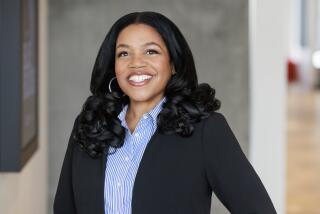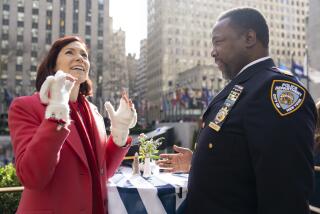Broadcasting the big strides in TV diversity
When Fox’s “Sleepy Hollow” became a hit this season, critics and viewers were so bowled over by its crazy-great premise — Ichabod Crane as a colonial war hero! Back to fight the Four Horseman of the Apocalypse! — that another revolutionary aspect of the show was often overlooked.
It has four non-white main characters.
Yes, Tom Mison’s resurrected British-turned-Colonial soldier serves as the story’s center, but “Sleepy Hollow” is also led by police detective Lt. Abbie Mills (Nicole Beharie), with Abbie’s sister Jenny (Lyndie Greenwood), Capt. Frank Irving (Orlando Jones) and former-cop-turned-demon-acolyte Andy (John Cho), serving as supporting leads.
All on a show not created by Shonda Rhimes.
BEST TV OF 2013 Lloyd | McNamara
“Sleepy Hollow” is not alone. The 2013-14 season included a relatively large number of lead characters from categories previously considered “minorities” in the television universe: female, black, Asian, Indian, and/or gay. “Brooklyn Nine-Nine,” has, amid its notably diverse characters, television’s first married, gay, black police captain, played with deadpan perfection by Andre Braugher.
Not all of them worked — the Blair Underwood reboot of “Ironside” tanked, as did the Anglo/Latino comedy “Welcome to the Family” — but “Sleepy Hollow” and “Brooklyn Nine-Nine” got second seasons.
They joined several returning shows with similarly arrayed ensembles, including “New Girl,” “Elementary,” “Revolution” and, of course, Rhimes’ “Scandal,” for which Kerry Washington recently became the first black woman to be nominated for a lead actress in a drama series Emmy since 1995.
None of these shows, you may notice, is on cable networks. While premium and basic cable continues to get the lion’s share of the credit for television’s recent renaissance, it’s the Big Four (and, it must be said, Netflix’s “Orange Is the New Black”) that are pushing the boundaries.
This broadcast trend flies in the face of conventional “wisdom,” which has for years argued that shows featuring female, black, Latino, Asian or gay leads could only muster niche audiences. It has been taken as gospel that viewers in the heartland, i.e. Americans with conservative values, just aren’t ready for anything beyond the pale of “traditional” programming.
So why is it that cable, with its more upscale demographic and boutique ratings-tolerance, remains so overpopulated with white men while broadcast, which lives and dies by big numbers, seems to be finally embracing the rainbow?
Certainly some of the credit goes to Rhimes. It was Rhimes, rather than one of the Big Boys of cable, who, as a first time creator / show runner, called out the industry for its inexplicable lack of diversity.
A decade ago, when the original auditions for “Grey’s Anatomy” yielded mostly white actors, Rhimes demanded, and got, a wider array of color. “Grey’s Anatomy” became a showcase for all manner of seldom-seen-on-TV diversity.
CRITICS’ PICKS: What to watch, where to go, what to eat
More important, it was a huge hit. Notable for her female-centric writers’ room, something unheard of at the time (and still rare), Rhimes became a cause célèbre, the herald of a time when racial, gender and sexual diversity would soon become the norm.
Which it did, on any show created by Rhimes.
Everywhere else, white straight male leads continued to dominate to such an extent that other characters, including women, bordered on extinction. For several years, Tina Fey, Emily Deschanel and Mariska Hargitay seemed to stand alone.
The rise of “prestige drama” actually made things worse rather than better. While the tonal palette of HBO, Showtime, FX, and then AMC, History, Sundance and IFC, trended dark, the casts, with a few notable exceptions — the oeuvre of David Simon, the last season of “American Horror Story,” “The Bridge” — remained very pale.
Very recently, shows specifically created to rectify the imbalance have appeared, including “Devious Maids” on Lifetime and several Tyler Perry series on OWN. But the anointed “important” shows, like “Mad Men,” “Game of Thrones,” “Girls,” “Homeland” and “House of Cards,” regularly experiment with story in every way possible except racial diversity.
PHOTOS: Stories that leapt from big to small screen (and vice versa)
Strangely, the creator who has gotten the most flak for the penchant for the homogenous is “Girls” creator Lena Dunham. Like Mindy Kaling, who has also recently been criticized for the number of white men on her show, the fact that Dunham is a demographic anomaly (young, female) among her peers seems to imply a personal responsibility that male writers don’t share.
And that, of course, is the easy answer to cable’s diversity issues: Most of the writers are white men. As Maureen Ryan recently pointed out on the Huffington Post, not one woman or person of color has written an hour-long drama for HBO in the post-”Sopranos” era.
But the problem may be more ephemeral, and troubling, than that.
The recent boom in television began when taste-makers decided that television could be “smart.” For years, “The Sopranos” was the only exception to the pat proclamation among the elite that TV was for idiots and shut-ins.
Shows like “The Wire” and “Friday Night Lights” received similar dispensation, but it really wasn’t until “Mad Men” that popular opinion began to turn. Yet even as many broadcast network shows also shone with fine performances and great writing, the snobbishness continued, perfectly encapsulated in the term “prestige” drama.
PHOTOS: TV shows and their spinoffs
“Prestige” is just a half-step away from “elite,” and our nation’s president notwithstanding, we all know what color “elite” is.
As alarming as this may be, it does present a fine, and much needed, opportunity for the broadcast networks to finally pull out from cable’s shadow. For years, the Big Four tried to chase HBO and then Showtime by upping the violence, the sex and the profanity.
Instead, it may turn out that populism is the answer. The stories television, broadcast and cable, tells still represent only a narrow band of its audience.
But if 200-year-old Ichabod Crane can adapt to a world in which white men aren’t the only people whose lives matter, presumably TV can too.
More to Read
The complete guide to home viewing
Get Screen Gab for everything about the TV shows and streaming movies everyone’s talking about.
You may occasionally receive promotional content from the Los Angeles Times.







